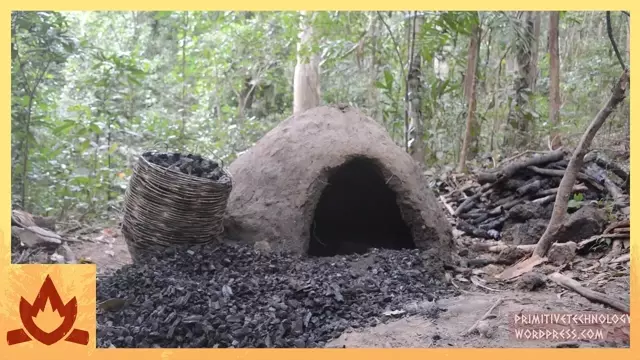2017-06-17
[public] 17.2M views, 284K likes, dislikes audio only
*Turn on captions for written commentary (CC in bottom right corner of screen). Charcoal is a valuable fuel that reaches a higher temperature than the very wood it’s made from. I’ve made some before, but with supplies running low due to furnace experiments, I decided to make another large batch of charcoal in a mound. I stacked the wood into a roughly conical shape (about 1 m wide and 75 cm high) and then built a thick wall of mud around the heap (this took 6 hours). Eight air entries were made in the base of the mound and one air exit hole was left at the top of the mound to allow the volatile components of the wood to escape while creating a natural draft to keep everything burning.
The mound was lit and the flame burned backwards down the heap in the opposite direction to the draft. This protects the coal made above the level of the fire from burning as carbon dioxide rushes past instead of oxygen, preventing combustion of charcoal. Each air entry was sealed only when fire became visible through them. This is an easy way to tell when to close them up, i.e. when the fire had burned down all of the wood in the heap. When the last air entry was closed, the air exit at the top of the mound was sealed, 5 hours after starting. The next day when cool, a large arched opening was made in the side of the mound to extract the charcoal. Despite a few unburnt brands the yield and quality was good filling almost 2 baskets.
To see if the kiln was reusable, I restacked it with timber cut from a fallen gum tree branch up the mountain. Due to the difficulty in reaching into the mound I stacked the wood in criss-crossed horizontal layers. The opening was sealed with mud and the mound lit as before. This time the mound burned quickly and I had to seal it early as the timber was burning at different rates, 3 hours after starting. Some large logs remained unburnt while charcoal that had already formed started to burn up being wasted as ash.
When I opened it the next day it had still produced an ok amount of charcoal but was disappointingly low compared to the first batch. This may partly be due to some of the wood being still green though it’s probably more likely to be due to how it was stacked. The lesson here is that when making charcoal the wood needs to be tightly stacked with few air spaces between. If not, the mound admits too much oxygen that quickly burns the timber.
Another thought I had was that wood may convert to charcoal better if laid vertically (or roughly so, like the cone in the first firing) so that the fire starts at the top of the wood and burns down. Stacking the wood in horizontal layers means that each layer has to set the one bellow alight leading to problems if the wood is green (use dry wood if stacking horizontally). By stacking wood vertically each piece is alight already and simply burns down towards the air entries. Stacking in this way also makes it easier to see fire in the air entries letting you know when to seal the mound.
For the reasons above I may make another charcoal kiln in future in the shape of a cylinder with air entries around the base and an open top. The kiln would be re-usable and easily stacked. A conical pile of wood would protrude above the walls of the kiln and be plastered in a temporary cover of mud. The kiln would be fired as with a normal mound and when finished the temporary cover of mud would be removed to extract the charcoal
Wordpress: https://primitivetechnology.wordpress.com/
Patreon page: https://www.patreon.com/user?u=2945881
I have no face book page, instagram, twitter etc. Beware of fake pages.
http://www.penguinrandomhouse.com/primitive-technology
/youtube/video/i9TdoO2OVaA
/youtube/video/uZGFTmK6Yk4?t=2
/youtube/channel/UCAL3JXZSzSm8AlZyD3nQdBA
/youtube/video/nG-rNHgFxhs
/youtube/video/RZGAYzItazw
http://www.penguinrandomhouse.com/primitive-technology

